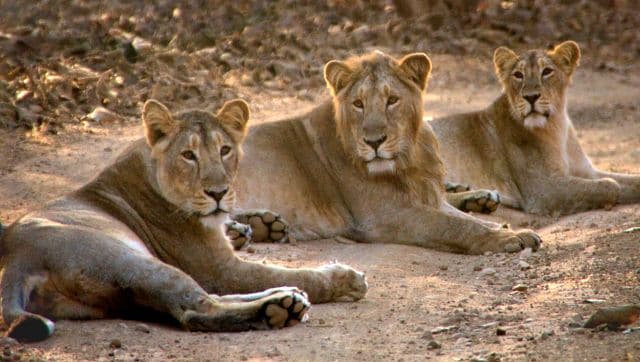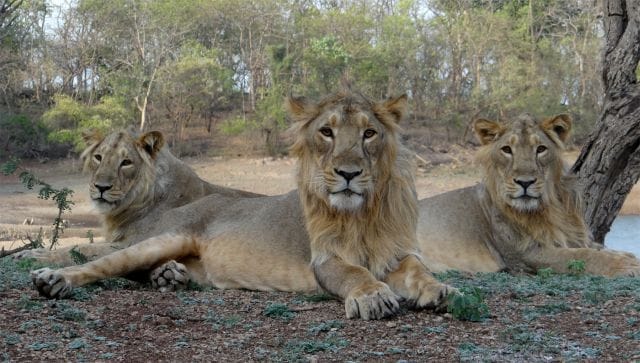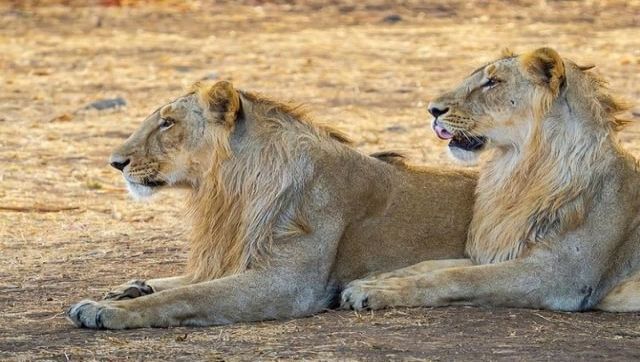Gujarat is finally moving lions from the Gir National Park to the Barda Wildlife Sanctuary. According to a report in Hindustan Times, the Centre has given the long-pending plan to shift some lions to the Barda Wildlife Sanctuary which is around 100 kilometres away in-principal approval. Let’s take a closer look at why the government is doing so: First, Gujarat is the only abode of Asiatic lions in India. According to the 2020 census, there are 674 lions in the state – a 29 per cent rise in its population compared to the 2015 census. The state has a total of 206 lions, 309 lionesses, 130 cubs and 29 other unidentified big cats. Of these, Gir alone accounts for around 400 lions, according to The Guardian. Environmentalists have been urging the state to make space for the big cats by spreading the lions out across India.
They say keeping the lions in close proximity leaves them vulnerable to disease.
However, the state has refused such demands – leading to charges of possessiveness of the big cats at the cost of their wellbeing. The decision comes months after Union Minister of State for Environment Ashwini Kumar Choubey told the Lok Sabha that the Lion@2047: A vision for Amrutkal report identified Barda Wildlife Sanctuary as a ‘potential site’ where a population of 40 adult and sub-adult lions can be accommodated in the larger landscape of Barda-Alech hills and coastal forests through natural dispersal. Hindustan Times quoted a copy of the report as saying, “Activities to prepare this sanctuary for future natural dispersal will be taken up. Herbivore population augmentation through breeding activities will be taken up. A large part of Barda is covered by thick Acacia Senegal – thickets of Gorad, which does not allow easy penetration of herbivores. This may be removed and replaced by sparse vegetation.” Officials told Hindustan Times that Barda Wildlife Sanctuary, which was established in 1979, is a ‘natural home’ for the lions. [caption id=“attachment_11037611” align=“alignnone” width=“640”] The Asiatic Lion also known as Panthera leo leo. Image Courtesy: Asiatic Lion Lodge[/caption] In January, the Gujarat forest department’s efforts to develop new habitats for the Asiatic lion got a boost after a big cat was spotted in Barda Wildlife Sanctuary – a first since Independence. The three-and-half-year-old male lion entered the sanctuary after spending considerable time near Porbandar town and preying on cattle, Principal Chief Conservator of Forests (Wildlife) Nityanand Srivastava told PTI. “It is a good sign a lion has been spotted inside Barda Wildlife Sanctuary for the first time after Independence. The Forest Department has been trying to develop this sanctuary as a second home for lions. We also run a breeding centre for herbivores in the sanctuary to increase the prey base,” Srivastava said. “The male lion was spotted in the Barda sanctuary and we got a report from our field staff about it around 9 am. It was campaigning in the Ratanpar village for some time and moved into the protected forest on its own,” state’s Forest, Environment and Climate Change Minister Mulubhai Bera told Indian Express at the time. “This is an important development as the forest department had been preparing Barda as a potential lion habitat for a very long time. A breeding centre of spotted deer is functioning there and now, there is a sufficient prey base for lions in that forest.” The lion, which was collared, is still in Barda, officials told Hindustan Times.
The Asiatic Lion also known as Panthera leo leo. Image Courtesy: Asiatic Lion Lodge[/caption] In January, the Gujarat forest department’s efforts to develop new habitats for the Asiatic lion got a boost after a big cat was spotted in Barda Wildlife Sanctuary – a first since Independence. The three-and-half-year-old male lion entered the sanctuary after spending considerable time near Porbandar town and preying on cattle, Principal Chief Conservator of Forests (Wildlife) Nityanand Srivastava told PTI. “It is a good sign a lion has been spotted inside Barda Wildlife Sanctuary for the first time after Independence. The Forest Department has been trying to develop this sanctuary as a second home for lions. We also run a breeding centre for herbivores in the sanctuary to increase the prey base,” Srivastava said. “The male lion was spotted in the Barda sanctuary and we got a report from our field staff about it around 9 am. It was campaigning in the Ratanpar village for some time and moved into the protected forest on its own,” state’s Forest, Environment and Climate Change Minister Mulubhai Bera told Indian Express at the time. “This is an important development as the forest department had been preparing Barda as a potential lion habitat for a very long time. A breeding centre of spotted deer is functioning there and now, there is a sufficient prey base for lions in that forest.” The lion, which was collared, is still in Barda, officials told Hindustan Times.
But not everyone agrees that Barda is a good choice.
Anish Andheria, the president of the Wildlife Conservation Trust, told The Guardian the state government has come up with a ‘misleading gimmick’ and that some lions in search of space had already crossed over to Barda. “Formally announcing Barda as a new lion sanctuary may lead to more funds and better management of the area, but it will not relieve the pressure on Gir. In fact, if Barda is made more lion-friendly, the lions will breed even faster there and the population will grow even further,” said Andheria. Andheria said the lions must be shifted to other parts of the country. “But Gujarat doesn’t want to do that,” he added. “It does not want to share the lion with other states. It wants to keep the lion for itself to enjoy the status of the only state in India that has lions. That’s why it keeps coming up with these frills and cosmetic changes that are no solution at all.” Wildlife expert and coordinator of Biodiversity Collaborative, Bengaluru, Ravi Chellam told PTI, “Barda cannot be a replacement for Kuno because it is barely 100 kilometres from Gir as the crow flies. Geographic separation is the primary objective of translocation to establish a second free-ranging population of lions to mitigate conservation risks”. If a cyclone hits Saurashtra, it is also likely to affect Barda, Chellam added. A hundred kilometres is not a large enough distance to prevent the spread of infectious diseases, he said. “Also, Barda barely spans 190 square kilometres. Lions are territorial animals. How many of them can be kept in an area of less than 200 square kilometres? Forty animals are not a self-sustaining population. Last but not the least, let us not forget that the 2013 order of the Supreme Court still remains to be implemented,” Chellam said. SC orders shifting to Kuno, Gujarat drags feet The Supreme Court had in 2013 ordered the government to translocate Asiatic lions from Gujarat to the Kuno National Park in neighbouring Madhya Pradesh within six months. [caption id=“attachment_10972571” align=“alignnone” width=“640”] Wildlife activists have been demanding that some lions be relocated for years. Image courtesy: Gir National Park[/caption] The apex court, saying the species is under threat of extinction and needs a second home, had directed the Ministry of Environment, Forest and Climate Change to shift them by October 2013.
Wildlife activists have been demanding that some lions be relocated for years. Image courtesy: Gir National Park[/caption] The apex court, saying the species is under threat of extinction and needs a second home, had directed the Ministry of Environment, Forest and Climate Change to shift them by October 2013.
However, the Gujarat government is still to send a single lion to Madhya Pradesh.
This despite studies identifying Kuno-Palpur sanctuary as the most suitable site for reintroducing the species, as per Indian Express. The government has asked for over 30 studies recommended by the International Union for Conservation of Nature (IUCN) to first be conducted in Kuno, as per the newspaper. While the IUCN recommends conducting these studies, it is not mandatory. “Irrespective of the number of eggs, you will lose all if you drop the basket. A second home for lions outside Gujarat is a must insurance for the species. It’s over five years now that the state is getting away with violating a Supreme Court order,” Ravi Chellam, biologist and member of the Supreme Court-appointed expert committee on the matter, told the newspaper in 2018. The Centre seems on the same page as Gujarat. The government in December told the Rajya Sabha in December that the translocation of the Asiatic lions from Gujarat to Madhya Pradesh will be done only after consultations between empowered committees of the two states covering all aspects, including evaluation of the habitat proposed, procedures and guidelines required to be followed and also the safety and security. Union Minister Ashwini Kumar Choubey also told the Lok Sabha that 240 lions have died in Gir forests between 2013-14 and 2022-23 (up to November 2022) as per the Gujarat Forest Department. The state government has taken various steps to prevent unnatural deaths of big cats such as appointment of veterinary doctors and introduction of an ambulance service for timely intervention and treatment of lions and other wild animals, Choubey said. Other measures include building speed-breakers and installing signboards on roads passing through sanctuary areas, regular foot patrolling in forests, building parapet walls for open wells near forests, putting up fences on both sides of the railway track near Gir Wildlife Sanctuary and radio-collaring Asiatic lions to track their movement, Choubey added. According to a report released by the Ministry of Environment, Forests and Climate Change in 2020, the lions in Gir have moved to forested patches through conducive corridors. They are now distributed in nine districts of Junagadh, Gir Somnath, Amreli, Bhavnagar, Botad, Porbandar, Jamnagar, Rajkot and Surendranagar, covering around 30,000 square kilometres, which is termed the Asiatic Lion Landscape.
With inputs from agencies Read all the Latest News , Trending News , Cricket News , Bollywood News , India News and Entertainment News here. Follow us on Facebook , Twitter and Instagram .
)